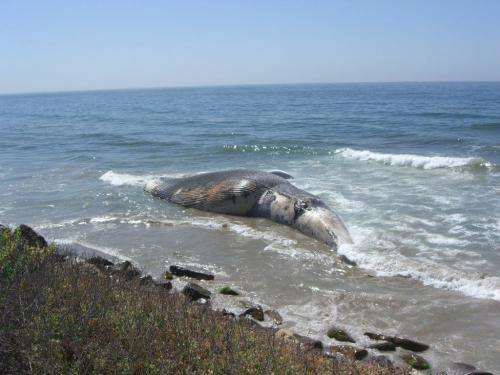Earwax used to develop new method of determining lifetime contaminant exposure in whales

(Phys.org)—Baylor University professors Stephen Trumble, Ph.D., and Sascha Usenko, Ph.D., have developed a novel technique for reconstructing contaminant and hormone profiles using whale earplugs, determining—for the first time—lifetime chemical exposures and hormone profiles—from birth to death—for an individual whale, information that was previously unattainable.
Using a blue whale's earplug, Trumble and Usenko were able to extract and analyze the stress hormone cortisol, testosterone, organic contaminants such as pesticides and flame retardants, and mercury, demonstrating that both man-made and endogenous chemicals are recorded and archived in whale earwax.
Their researching findings appear in the current issue of the Proceedings of the National Academy of Sciences of the United States of America and is available online.
"Scientists in the past have used this waxy matrix as an aging tool, similar to counting tree rings. Then, the question arose: Could whale earwax chronologically archive chemicals, such as man-made pollutants?" said Usenko, assistant professor of environmental science in Baylor's College of Arts and Sciences.
Over the past two years, Trumble and Usenko developed analytical methods capable of answering that very question.
"The type of information we can derive from these earplugs along with our methodology is exceptionally valuable. There is nothing like it. It really should be classified as a new field of research," Usenko said.

Historically, scientists have used whale blubber to determine hormone and chemical exposure, but that method only provides information over short, finite periods of time and can be difficult to obtain and cost-prohibitive.
"Whales are free-ranging animals and you can't get these types of profiles or information on free-ranging animals in any part of the world. This has never been done before," said Trumble, assistant professor of biology in Baylor's College of Arts and Sciences.
With these new data, the professors are able to assess the human impact on individual whales and multiple generations, as well as marine ecosystems.
"You have this 100-year-old question: How are we impacting these animals? There is ship traffic, environmental noise, climate change and contaminants. Now, we are able to provide definitive answers by analyzing whale earwax plugs," Usenko said.
In addition to using whale earplugs to determine whales' lifetime exposure to chemicals and environmental pollutants, the plugs provide time-specific biological information about whales.
"Our research was able to improve upon estimates of sexual maturity for blue whales. Previous estimates provided a 10-year range of maturity and we have been able to pinpoint exactly when the whale in the study hit sexual maturity. Our research was able to shed new light on the life cycle of whales," Trumble said.
Their new methodology will enable them to gain a deeper understanding of whales today and those that lived decades ago.
"We are able to go back in time and analyze archived museum earplug samples that were harvested in the 1950s and examine critical issues such as the effects of pollution, use of sonar in the oceans and the introduction of specific chemical and pesticides in the environment over long periods of time," Usenko said. "There are a myriad of ways that we can analyze plugs for a better understanding of marine ecosystems and these endangered animals. There is so much additional information that can be mined from studying earplugs."
More information: www.pnas.org/content/early/201 … 418110.full.pdf+html
Journal information: Proceedings of the National Academy of Sciences
Provided by Baylor University


















